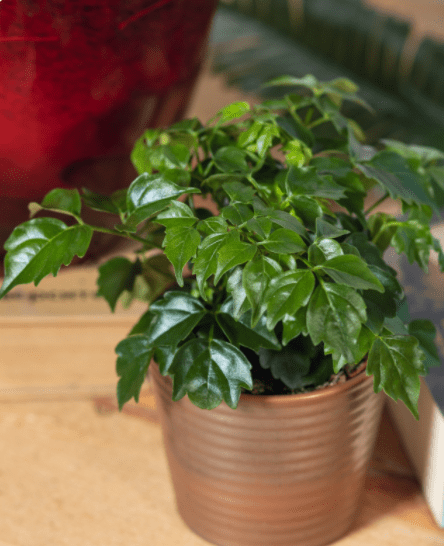All About Schefflera
Schefflera [Schefflera arboricola (Hayata) Merr.] is the most well-known ornamental house plant propagated through seeds. The rapid proliferation of elite clones is a significant factor in the market for pot plants.
Schefflera can be described as a genus of tropical plants with two great indoor plants of tropical origin species. The bigger Schefflera Actinophylla (sometimes described as the umbrella tree, also sometimes mispronounced “sheflara”) has large oval, shiny leaves that hang gracefully from a central stalk resembling an umbrella.
The mature plant may produce between 12 and 16 leaflets from one stalk, whereas an immature plant is likely to have four or six leaves.
Schefflera arboricola (sometimes called the dwarf Schefflera) has smaller, glossy leaves, often with cream-colored variegation. In addition to the plant’s small size, it appears like its taller counterpart.
Schefflera plants are only hardy up to USDA zone 10. They can be planted indoors throughout the year in colder climates and are placed outdoors in warmer seasons.
In the indoor environment, they flourish alongside other tropical species. But, they are not likely to bloom indoors. It is usually placed outdoors to show their long, white, red, or pink tentacle-shaped flowers.
These plants are quick-growing when placed outdoors, where they can increase by 3 feet each year. Indoor plants grow slower and are best kept in a small space, mainly when restricted to a tiny pot.
If you’re planning to plant the Schefflera plant in the garden of a warmer climate, It is recommended to plant them in the fall or spring when it isn’t scorching hot. The entire Schefflera plant is harmful to humans as well as to animals.
Schefflera Plant Profile
Family: Araliaceae
Common Names: Umbrella Tree, Schefflera, Octopus Tree
Native to: Northern Territories of Australia, New Guinea, and Java, in tropical rainforests
Description: A large tree that tends to be multi-trunked when mature. The leaves, usually grouped at the ends of the trunks, are compound, roughly circular, with 7 to 16 leaflets 4 to 12 inches long, oblong, shiny, and dark green.
The entire 2 to 4-foot leaf is held on a 2-foot long stalk or petiole. Red flowers, produced in the late summer and fall, are individually small, an inch or so across, arranged on several stalks above the foliage in finger-like groups.
The purple-red fruit is a drupe or stone-fruit like a peach produced in abundance. The plant group or Genus was named by a 19th-century botanist, J.C. Scheffler.
Hardiness: Native to frost-free areas; is now found growing outside in USDA Zones 10-12.
Height/Width: A narrow tree that grows to 40 feet tall.
Light: Grows in shade and sun locations.
Soil/Moisture: Moist soil, well-drained locations are preferred but will (and has) adapted to just about anywhere.
Issues: Schefflera is a famous tree for interiors. It holds up to permanent installation in containers in the home and commercial locations, standard in mall interiorscapes. As an interior plant, it is challenging, grows in moderate light, and is pest-resistant.
Outside is where Schefflera becomes problematic. It was introduced to the Florida landscape in 1927; by the late 1970s, its escape and invasion into native areas via bird distribution of the prolific seeds were noted throughout south Florida.
Though Schefflera is native to the northern provinces of Australia, its escape and invasion are becoming a problem in southern Australia, as it is on Hawaii and several other Pacific Islands.
Today, Schefflera is found in dunes and high scrub habitats to tropical hammocks, wetlands, and home landscapes. The rapid spread of Schefflera is reported to be shading out endangered, threatened, and rare plant species in sensitive habitats.
In the urban landscape, removal of the masses of seedlings produced by nearby trees increase maintenance cost and, if left unchecked, will cause the decline of preferred plantings.
Dwarf Schefflera

Scientific name: Schefflera arboricola Dazzle
Family: Araliaceae
Common names: Dazzle Schefflera, dwarf Schefflera, arboricola
Native to Schefflera arboricola is native to the subtropical forests of Taiwan. Dazzle is a sport (mutation on a portion of an existing plant) found in a breeding program in Homestead.
Description: A tropical evergreen vining shrub. The leaves are compound, roughly circular, with about eight leaflets 3 to 5 inches long, 2 inches wide, and very smooth. They are broader at the tip than the base, pointed at the end, and heavily variegated with creamy yellow.
They are held on the green, 6- to 8-inch-long leaf stems that line the stems. Flowers and, therefore, the fruit has not been observed on Dazzle. The plant group or Genus was named by 19th-century botanist J.C. Scheffler.
Hardiness: USDA zones 9-12; will show some damage in heavy frost.
Height/width: A new plant on the market; height is expected to reach 10 to 15 feet and width 4 to 8 feet.
Light: Grows in shade and sun locations.
Soil/Moisture: Moist soil, well-drained locations are preferred, but it is adaptable to poor locations. Moderately drought tolerant once established; prefers regular water applications for best growth.
Culture and uses: Use Dazzle as a rambling border or pruned hedge. It is lovely as a clambering garden specimen on a trellis or an espalier (plant trained to grow flat against a wall).
Dazzle is an excellent houseplant in a bright window. The highly variegated leaves are more susceptible to sunscald in sunny, hot locations; partial shade or shade in the warmest part of the day is best.
This large vining plant will spread carelessly without pruning or support. However, it will not respond well to shearing; prune by hand for shaping and size control.
Generally, arboricola is not a heavy feeder; use a slow-release, balanced fertilizer two to four times per year. Mulch well to preserve moisture and suppress weeds.
Misuses and problems: Dazzle is susceptible to aphids, scales, and spider mites, as is the more common dwarf Schefflera.


























